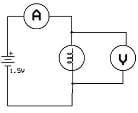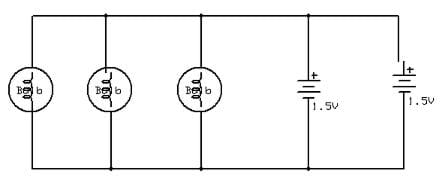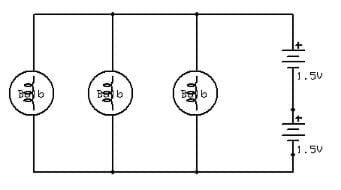Quick Look
Grade Level: 10 (9-12)
Time Required: 3 hours
(can be split into different days)
Expendable Cost/Group: US $10.00 $10 is the materials cost for the entire class and $9 worth are reusable.
Group Size: 3
Activity Dependency: None
Subject Areas: Physics, Science and Technology

Summary
In this extension to the Ohm's Law I activity, students observe just how much time it takes to use up the "juice" in a battery, and if it is better to use batteries in series or parallel. This extension is suitable as a teacher demonstration and may be started before students begin work on the Ohm's Law I activity.Engineering Connection
Ohm's law is the basis of all electrical systems. Electrical engineers use this equation to guide the design of electrical systems. Students need a strong foundation in Ohm's law while designing circuits on their own.
Learning Objectives
Application of the following:
- Ohm's law
- series/parallel circuits (ways to connect them and have an effect on V and I)
- circuit components
- power
- devices that can be used to measure voltage and current
Educational Standards
Each TeachEngineering lesson or activity is correlated to one or more K-12 science,
technology, engineering or math (STEM) educational standards.
All 100,000+ K-12 STEM standards covered in TeachEngineering are collected, maintained and packaged by the Achievement Standards Network (ASN),
a project of D2L (www.achievementstandards.org).
In the ASN, standards are hierarchically structured: first by source; e.g., by state; within source by type; e.g., science or mathematics;
within type by subtype, then by grade, etc.
Each TeachEngineering lesson or activity is correlated to one or more K-12 science, technology, engineering or math (STEM) educational standards.
All 100,000+ K-12 STEM standards covered in TeachEngineering are collected, maintained and packaged by the Achievement Standards Network (ASN), a project of D2L (www.achievementstandards.org).
In the ASN, standards are hierarchically structured: first by source; e.g., by state; within source by type; e.g., science or mathematics; within type by subtype, then by grade, etc.
International Technology and Engineering Educators Association - Technology
-
Energy cannot be created nor destroyed; however, it can be converted from one form to another.
(Grades
9 -
12)
More Details
Do you agree with this alignment?
State Standards
Massachusetts - Science
-
Identify and explain the components of a circuit, including sources, conductors, circuit breakers, fuses, controllers, and loads. Examples of some controllers are switches, relays, diodes, and variable resistors.
(Grades
9 -
12)
More Details
Do you agree with this alignment?
-
Explain the relationships among voltage, current, and resistance in a simple circuit, using Ohm's law.
(Grades
9 -
12)
More Details
Do you agree with this alignment?
-
Explain how to measure and calculate voltage, current, resistance, and power consumption in a series circuit and in a parallel circuit. Identify the instruments used to measure voltage, current, power consumption, and resistance.
(Grades
9 -
12)
More Details
Do you agree with this alignment?
Materials List
We suggest the following materials be bought in bulk and used yearly:
- 4 AAA general purpose (C-Zn) batteries
- 2.47 V, 300 mA light bulbs
- 10-12 alligator clips and wires
- stopwatch
Recommended:
- 4 single battery holders
- 2 double battery holders
- 6 lamp holders
Worksheets and Attachments
Visit [www.teachengineering.org/activities/view/wpi_ohm2_act_joy] to print or download.Introduction/Motivation
Question:
We have three light bulbs arranged in a parallel circuit. If the batteries used to power them are also arranged in parallel, will they last longer than batteries arranged in a series?
Explanation:
A battery company wants to know how long its batteries will last for consumers. Voltage is very easy to measure, however finding the current is much harder. So, let's set up an experiment to time the battery life according to series and parallel circuits.
The batteries in a series give off a brighter light; however they last about half the time of batteries in parallel.
Batteries set up in a parallel circuit give a less intense light, but last twice the length of batteries in series.
Procedure
- Build a circuit with 3 bulbs wired in parallel to 2 batteries wired in parallel as shown in Figure 1.

Figure 1 - Build a circuit with 3 bulbs wired in parallel to 2 batteries wired in series as shown in Figure 2.

Figure 2 - Have students guess how long each circuit will last.
- Measure the total current flowing through each circuit.
- Time how long it takes for the bulbs to stop giving off light.
Results in Testing
- Time for series: ~20 minutes
- Time for parallel: ~ 40 minutes
Assessment
Homework or Quiz: Assign students to answer the seven questions in the Questions for Students Handout. Review their answers to gauge their depth of comprehension.
Activity Extensions
Conduct Ohm's Law 1, an activity in which students work to increase the intensity of a light bulb by testing batteries in series and parallel circuits.
Subscribe
Get the inside scoop on all things TeachEngineering such as new site features, curriculum updates, video releases, and more by signing up for our newsletter!More Curriculum Like This

Students learn that charge movement through a circuit depends on the resistance and arrangement of the circuit components. In one associated hands-on activity, students build and investigate the characteristics of series circuits. In another activity, students design and build flashlights.

Students are introduced to several key concepts of electronic circuits. They learn about some of the physics behind circuits, the key components in a circuit and their pervasiveness in our homes and everyday lives.

Students learn about current electricity and necessary conditions for the existence of an electric current. Students construct a simple electric circuit and a galvanic cell to help them understand voltage, current and resistance.

Students explore the composition and practical application of parallel circuitry, compared to series circuitry. Students design and build parallel circuits and investigate their characteristics, and apply Ohm's law.
Copyright
© 2013 by Regents of the University of Colorado; original © 2005 Worcester Polytechnic InstituteContributors
Ozan BaskanSupporting Program
K-12 Outreach Office, Worcester Polytechnic InstituteAcknowledgements
Creation of this activity was funded by Pratt & Whitney.
Last modified: August 22, 2018









User Comments & Tips